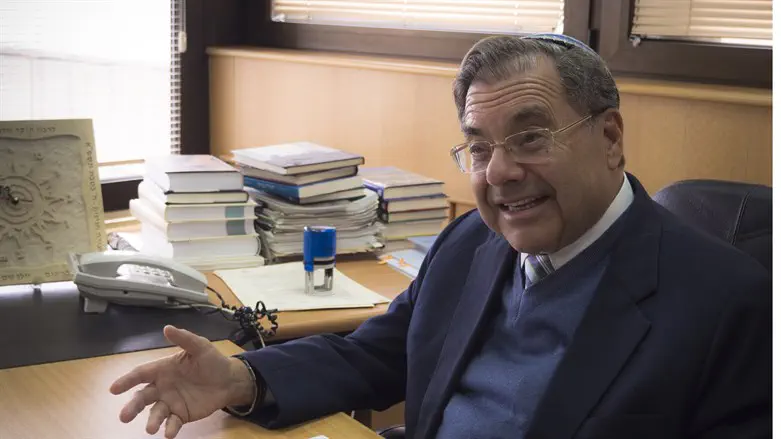
Efrat, Israel –“And they shall make Me a mishkan, that I may dwell among them.” (Exodus 25:8)
What is the significance of the mishkan (tabernacle) to Judaism, the Jewish people, and the world?
Two perspectives from our tradition offer answers that I believe provide insights that will imbue our daily lives with additional meaning and spread the light of Torah to all of humanity.
The great commentator Nahmanides [13th Century Spain and Israel] maintains that the primary purpose of the mishkan is to perpetuate the Sinaitic revelation, a central temple from which the Divine voice would continue to emanate and direct the Jewish people. This is why the very first aspect of the mishkan that the Bible describes is the Ark, the repository of the sacred Tablets of Stone, over which is the Ark-cover [kapporet] with its two cherubs. The Torah testifies in the name of God:
“And I shall meet with you there, and I shall tell you from above the kapporet, from between the two cherubs, which is on top of the Ark of Testimony, everything which I will command you [to communicate] to the People of Israel” (ibid. 25:22).
Similarly, Moses articulates this idea in describing the revelation at Sinai: “God spoke these words to your entire assemblage from atop the mountain amidst the fire, the cloud and the fog, a great voice that never ceases” (Deuteronomy 5:19 and Targum Onkelos ad loc.). It therefore is quite logical that throughout the Second Temple—in the absence of the sacred Tablets and the gift of prophecy—the Great Sanhedrin sat within the Holy Temple. From the Sanctuary [mishkan] must emanate the word of God!
Since the function of the Oral Torah is to keep God’s word alive and relevant in every generation, Nahmanides maintains that the primary purpose of the mishkan was to teach and inspire Israel and humanity with the eternal word of the Divine.
From this perspective, after the destruction of the Second Temple, synagogues and study halls—our central institutions of Torah reading, learning and interpretation—are the spiritual heirs to the mishkan.
Mystical and Hassidic interpretations see in the mishkan yet another goal: the building of a home in which the Almighty and Israel (and ultimately, all of humanity) will dwell together. The revelation at Sinai symbolizes the betrothal-engagement between God and Israel, with the marriage contract being the tablets of stone, the biblical laws. The commandment to construct a mishkan thus means a need to build the nuptial home in which the Almighty “bridegroom” unites with His bride, the Jewish people.
Hence, the accoutrements of the mishkan are an Ark (a Repository, or Closet, as it were, which encased the tablets), Menorah-Candelabrum, and a Table for the showbread—the usual furnishings of a home—as well as an Altar, which expresses sacrifice. Therefore, if the Almighty created a world in which humanity can dwell, the Jews must return the compliment and create a mishkan so that God will feel comfortable with us and be enabled, as it were, to dwell in our midst here on earth. From this perspective, the heir to the destroyed Holy Temples is the Jewish home.
And it is because Judaism sees the home as a “miniature mishkan” that home-centered family ritual celebrations bear a striking parallel to the religious ritual of the Holy Temple even to this day.
A striking example of this notion is the weekly Friday Night Shabbat meal. Even before the sun begins to set, the mother of the family kindles the Shabbat lights, reminiscent of the priests’ first task each day to light the Menorah. The blessing over the Kiddush wine reminds us of the wine libations accompanying most sacrifices, and the carefully braided loaves of challah symbolize the twelve loaves of Temple showbread.
Moreover, parents bless their children with the same priestly benediction with which the High Priest blessed those in the Temple, and the ritual washing of the hands before partaking of the challah parallels the hand ablutions of the priests before engaging in Temple service. The salt in which we dip the challah before reciting the blessing over bread is based upon the biblical decree, “With all of your sacrifices shall you offer salt.” (Leviticus 2:13), since salt, which is an external preservative, is symbolic of the indestructibility of God’s covenant with Israel.
The analogy continues to the zemirot (songs) that we sing and the Torah that we speak about during the meal, which will hopefully further serve to transport the family participants to the singing of the Levites and the teachings of the priests in the Holy Temple. Such a Shabbat meal links the generations, making everyone feel part of the eternal people participating in an eternal conversation with the Divine.
Ultimately, whether in the synagogue or the home, we are blessed by God with ample opportunities to perpetuate the revelation at Sinai every day. Through the sanctification of our lives in each of these places of holiness, may we merit to witness the rebuilding of the Holy Temple itself, and the restoration of the full glory of God as experienced at Sinai, speedily and in our days.